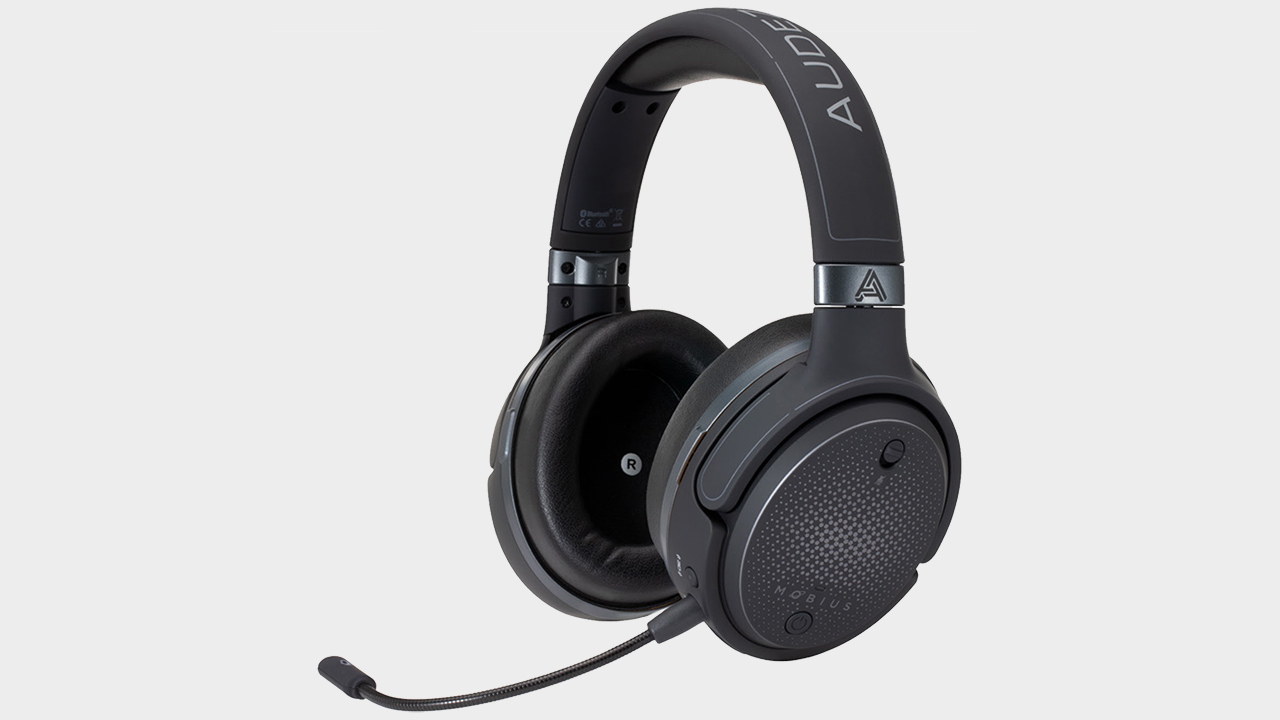Our Verdict
The Audeze Mobius provides excellent game sound and 3D audio but limited as a wireless headset.
For
- Excellent Sound
- Great Headtracking
- Bluetooth
- Comfy
Against
- Expensive
- Poor Battery life
- Irrationally Short USB-C cable
- No Surround Sound on Bluetooth
PC Gamer's got your back
Audeze has joined the likes of JBL and Creative as another premium headphone maker entering the world of gaming with its own line of gamer-focused headsets. And, out of all gaming headsets that have stretched over my big head this year, the Audeze Mobius might be the most impressive-sounding ones out there. It's also the most expensive gaming headset I've used this year at $400.
The reason the Mobius is such a pricey headset is that it uses high-end planar magnetic drivers instead of dynamic drivers; the sort you'll find in most gaming headsets. Even at $400, the Mobius is actually on the affordable end of the planar headset price spectrum, with some costing upwards of $1,800. And if you're spending that much on a headset, you're probably working in music production or just a hardcore audiophile. So if you were wondering why you don't see more gaming headsets with planar magnetic drivers, the cost is likely it.
Headphones with planar magnetics drivers tend to have a wider and more accurate range of sound compared to most dynamic drivers, and at the end of day they sound incredible. So, the Mobius may have great sound, but is it $400 great?
As soon as you put these bad boys on, it's easy to hear the difference in sound quality from your usual gaming headset. It's almost shocking that games and music could sound this awesome. The wider range provided by the Mobius' planar drivers, especially in shooters, did a spectacular job of delivering a rich and detailed sound stage. I heard every shot whizz by my head and every creeping footstep before my eventual demise in my matches of Call of Duty Warzone. Its Hi-Res mode also gave me the bass I wanted when listening to music, something I found lacking in both the 3D and digital 7.1 surround sound modes. The Audeze Mobius provided one of the best listening experiences I've had in a while.
As someone who used a Blue Ella headset for years, I know first hand that these planar magnetic headphones can get heavy. So, I was surprised how comfortable these felt even after hours of use. I usually get a little annoyed when premium headsets are all plastic, but it makes sense in the case of the Mobius because the lighter weight offsets the heavier drivers and makes the whole thing more comfortable.
As impressed as I am by the planar magnetic drivers, I'm not impressed by 3D audio in general. But I will say that the Audeze Mobius is one of the headsets I've tested this year that really does it well. What makes the Mobius' 3D different is how well it uses its integrated Waves Nx head-tracking tech, with built-in gyroscopes inside the headset. The 3D audio works right out of the box with minimal tweaking and no need for calibrating (looking at you, JBL Quantum One).

Driver-type: 100mm Planar Magnetic
Frequency response: 10Hz - 50,000Hz
Microphone frequency response:
Design style: Over-ear
Microphone: Detachable boom mic
Connectivity: Type-C to A cable with Game /Chat Balance Dial, 3.5mm audio cable, Bluetooth
Weight: 350g
Price: $399.99
There are two modes for 3D audio: auto and manual. Auto will dynamically shift the audio source to wherever you move your head, whereas manual leaves the source in front of you. While having the headset automatically shift the audio source base on your head movement is cool in theory, I found that it tends to mess with the audio balance in ways that sound rough. Manual sets the audio source to be in front of you, which is the better way to use its 3D audio for music and gaming and makes the most sense.
The effects of the 3D audio Auto setting is that the sound will pan as you move your head from left to right, which is a neat novelty but a really distracting way to listen to music. The real issue is how often anyone actually uses 3D audio outside of VR gaming, where it seems practical to have the sound move with as you whip your head around.
You could make a case that this may be beneficial, while playing something like a battle royale, for pinpointing where shots or footsteps are coming from. Honestly, digital 7.1 surround sound already does a pretty decent job at that anyway if you're looking to get from audio from all angles, and this just seems like overkill. I generally just ended up switching off 3D sound when playing shooters.
Personally, I found the 3D audio really useful in exploration games like Death Stranding, where being surrounded by a lot of ambient noise very relaxing. On the opposite end, I replayed the first bits of Resident 7 and was made to feel generally uncomfortable and creeped out as I explored a decrepit murder house.
Since the Mobius is Audeze's first gaming headset, there are some rookie mistakes I'm hoping they address in the future. First off, the wireless connectivity. While most wireless headsets offer 5GHz or 2.4GHz connections via some sort of USB dongle. The Mobius only offers Bluetooth. Don't get me wrong, these being Bluetooth compatible is great, and I loved the fact that I could easily connect to my phone. The issue is that 7.1 surround sound doesn't work when it's connected via Bluetooth. It's a shame because the USB-A to USB-C that comes with the headset is criminally short at 4 feet. As someone who uses a standing desk, I often found myself at odds with the cable. If I were to plug this into one of my PC's rear USB ports, the headset would be basically unusable.
That being said, this headset should mostly be used wired chiefly because I got a measly nine hours of battery life, by no means should you treat this as a genuine wireless gaming headset. I was also a little disappointed in seeing limited EQ settings with only 8 sound profiles. As someone who needs an aggressive amount of bass to sustain life, I was surprised to see that the AudezeHQ software goes deep as far as HRTF customization goes with settings for head circumference, and even room ambiance, but nothing for EQ settings, just 8 sound profiles.

If you're dead set on getting yourself a gaming headset with the Audeze 100mm planar magnetic drivers and Waves Nx head tracking, the HyperX Cloud Orbit S is literally the same exact headset as the Mobius, but minus the Bluetooth, and nearly $50 cheaper at most retailers. Then there's the straight HyperX Cloud Orbit which is cheaper again, ditches the head tracking, and still delivers the same excellent wired aural experience.
Despite the few issues I had with the Mobius (and my severe dislike of 3D audio as a concept), it still remains one of the best-sounding gaming headsets. The magnetic planar drivers really set it apart from other gaming headsets, offering almost unrivaled sound quality. It's tough to give a full-throated recommendation because of its miserable battery life, lack of customization, and high price. Though, if you care more about your games sounding their best over anything else when gaming and have a credit card with a high limit, the Audeze Mobius will knock your socks off.
The Audeze Mobius provides excellent game sound and 3D audio but limited as a wireless headset.

Jorge is a hardware writer from the enchanted lands of New Jersey. When he's not filling the office with the smell of Pop-Tarts, he's reviewing all sorts of gaming hardware, from laptops with the latest mobile GPUs to gaming chairs with built-in back massagers. He's been covering games and tech for over ten years and has written for Dualshockers, WCCFtech, Tom's Guide, and a bunch of other places on the world wide web.


